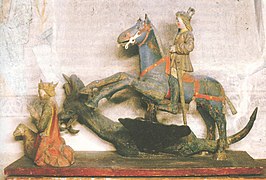Holy Cross Church, Hattula
- Machine translation, like DeepL or Google Translate, is a useful starting point for translations, but translators must revise errors as necessary and confirm that the translation is accurate, rather than simply copy-pasting machine-translated text into the English Wikipedia.
- Do not translate text that appears unreliable or low-quality. If possible, verify the text with references provided in the foreign-language article.
- You must provide copyright attribution in the edit summary accompanying your translation by providing an interlanguage link to the source of your translation. A model attribution edit summary is
Content in this edit is translated from the existing Finnish Wikipedia article at [[:fi:Hattulan Pyhän Ristin kirkko]]; see its history for attribution. - You may also add the template
{{Translated|fi|Hattulan Pyhän Ristin kirkko}}to the talk page. - For more guidance, see Wikipedia:Translation.
The Holy Cross Church (Finnish: Pyhän Ristin kirkko) in Hattula, Finland, is the oldest church in the former Tavastia (Häme) province.[1]
Archaeologist and art history professor Markus Hiekkanen has shown that construction of the current brick building spanned the period from 1472 to 1490 and that the building did not date to the 14th century, as previously thought.[2]
Unique for having been built almost entirely of brick rather than stone, the church was a popular pilgrimage destination during the Middle Ages. A grey stone perimeter wall was added in the 16th century.[1] The church contains paintings from the years 1510 through 1922, as well as 40 wooden sculptures dating to the first half of the 14th century.[1] Precious-metal crowns which had formerly belonged to the church were confiscated during the Reformation. The church pulpit, dating to 1550, is the oldest surviving pulpit in Finland. A second pulpit was built in the 17th century. A bell tower next to the church dates to 1813.
The Hattula church is known for its lime paint frescoes done in late Gothic style, likely completed by the same group of artists who later painted the St. Lars church in Lohja (Finnish: Pyhän Laurin kirkko).
-
 The old Hattula church
The old Hattula church
1926 photo by Kalle Artturi Havas -
 Interior
Interior -
 Frescos
Frescos -
 St. Ursula
St. Ursula -
 Mediaeval carving of St. George and dragon, from Hattula church
Mediaeval carving of St. George and dragon, from Hattula church
Kari Tarkiainen, Sveriges Österland, p. 93. -
 1931 postage stamp depicting the church
1931 postage stamp depicting the church
References
- ^ a b c "Pyhän Ristin kirkko" (in Finnish). Hattulan seurakunta [Hattula Parish]. Archived from the original on 20 July 2011. Retrieved 8 October 2010.
- ^ Hiekkanen, Markus (2003). Suomen kivikirkot keskiajalla [Finnish stone churches of the Middle Ages] (in Finnish). Otava. p. 231. ISBN 951-1-15126-6.
Further reading
- Okkonen, Onni (1955). Suomen Taiteen historia [History of the Art of Finland] (in Finnish). WSOY. p. 111.
- Sarajas-Korte, Salme, ed. (1987). Ars – Suomen taide 1 [Ars – Art of Finland 1] (in Finnish). Otava. p. 170. ISBN 951-35-4202-5.
External links
 Media related to Hattula church of the Holy Cross at Wikimedia Commons
Media related to Hattula church of the Holy Cross at Wikimedia Commons- Hattula Parish – Holy Cross Church (in Finnish)
- v
- t
- e

















